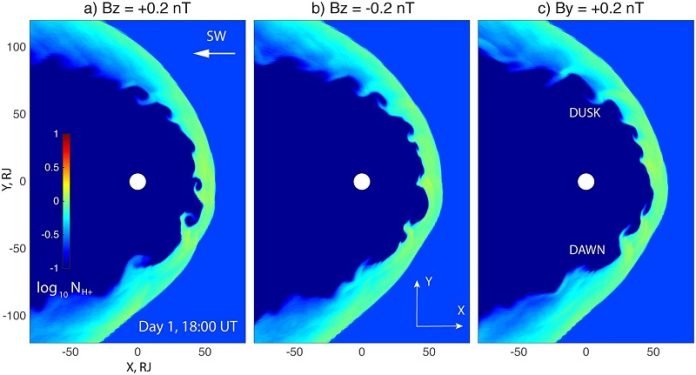
NASA’s Juno spacecraft, which is currently orbiting Jupiter, has made an exciting discovery.
Scientists from the Southwest Research Institute (SwRI) and The University of Texas at San Antonio (UTSA) found that Juno often encounters enormous, swirling waves at the boundary where the solar wind, a stream of charged particles from the Sun, meets Jupiter’s magnetic field.
This area, known as the magnetosphere, is where the solar wind interacts with Jupiter’s magnetic field.
This interaction is essential because it transfers energy and matter from the solar wind to Jupiter’s space environment.
Think of it as a cosmic dance where the Sun’s charged particles swirl and twirl with Jupiter’s magnetic field.
Jake Montgomery, a doctoral student involved in the project, explains that these swirling waves, also known as Kelvin-Helmholtz waves, happen when there’s a significant speed difference between two areas in space.
These waves create a vortex or a spinning motion at the boundary that separates a planet’s magnetic field and the solar wind.
Although we can’t see these waves with our naked eye, scientists can detect them through special instruments that observe plasma and magnetic fields in space.
Plasma is a state of matter made up of charged particles, ions, and electrons, and it’s found everywhere in the universe.
“These swirling waves are a fundamental process that happens when the solar or stellar winds interact with planetary magnetic fields not only in our solar system but across the universe,” Montgomery said. Juno’s observations confirmed that these waves play an active role in the interaction between the solar wind and Jupiter.
Montgomery is the lead author of a study published in Geophysical Research Letters that uses data from several of Juno’s instruments, including its magnetometer and the Jovian Auroral Distributions Experiment (JADE).
Dr. Robert Ebert, a scientist at SwRI and professor at UTSA, said, “Juno’s extensive time near Jupiter’s magnetosphere has allowed detailed observations of phenomena like these swirling waves.
This solar wind interaction is crucial as it can carry plasma and energy into Jupiter’s magnetosphere, sparking activity within that system.”
Follow us on Twitter for more articles about this topic.



